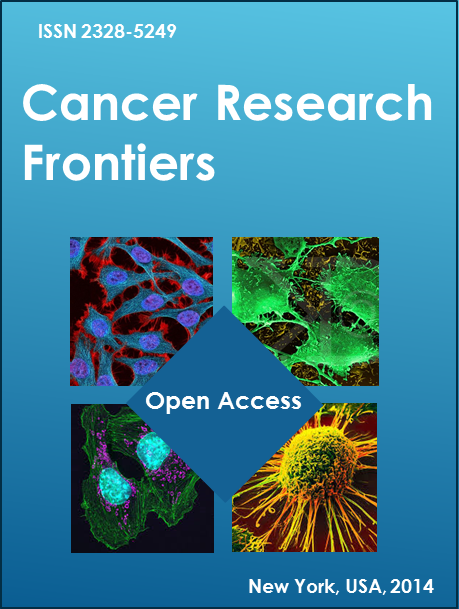Abstract _ Full Text (HTML) _ Full Text (PDF)
Review
Cancer Research Frontiers. 2015 Apr; 1(2): 138-148. doi: 10.17980/2015.138
New Insights into Laryngeal Squamous Cell Carcinoma: Cancer Stem-Like Cells
Esra Guzel1, Omer Faruk Karatas2, Mete Emir Ozgurses1, Mustafa Ozen1,3*
1Department of Molecular Biology and Genetics, Biruni University, Istanbul, Turkey.
2Molecular Biology and Genetics Department, Erzurum Technical University, Erzurum, Turkey.
3Department of Pathology & Immunology Baylor College of Medicine, Houston, TX, 77030, USA.
*Corresponding author: Dr. Mustafa Ozen, Department of Medical Genetics/Molecular Biology and Genetics, Biruni University, 10. Yil Caddesi Protokol Yolu No: 45 34010 Topkapi, İstanbul, Turkey. Tel: Fax: +90 212 416 46 46. E-mail:
Citation: Guzel E, et al. New Insights into Laryngeal Squamous Cell Carcinoma: Cancer Stem-Like Cells. Cancer Research Frontiers. 2015 Apr; 1(2): 138-148. doi: 10.17980/2015.138
Copyright: @ 2015 Guzel E, et al. This is an open-access article distributed under the terms of the Creative Commons Attribution License, which permits unrestricted use, distribution, and reproduction in any medium, provided the original author and source are credited.
Competing Interests: The authors declare that they have no competing interests.
Received February 3, 2015; Revised March 28, 2015; Accepted April 15, 2015.
Abstract
The Cancer Stem-Like Cells (CSLCs) are cells with tumorigenic potential, which are involved in initiation, progression and spread of the tumor. Recent evidences in the last decade have suggested the existence of CSLCs in distinct types of tumors such as lung, brain, breast, prostate, colon, head and neck, ovarian and larynx cancers. They are identified by their tissue specific stem cell-like properties including self-renewal and having potential to differentiate.
Laryngeal squamous cell carcinoma (LSCC), originating from laryngeal epithelial tissue, is one of the most commonly diagnosed malignancies among the head and neck tumors worldwide. LSCC is frequently diagnosed among middle-aged people and its incidence has been reported to increase each year. Therapeutic options mostly cannot give positive clinical response especially for the advanced LSCC cases. LSCC is still one of the important causes of cancer deaths, particularly in men, worldwide, although the technologies in detection and diagnosis of LSCC have been significantly improved recently.
In this review, we have summarized the most current literature to understand the functions and roles of CSLCs in human LSCC. We believe that this review will contribute to knowledge of scientist not only working in LSCC field, but also studying the CSLCs in other cancers and diseases, and will help elucidating the roles of CSLCs implicated in LSCC initiation, development, progression, and chemo-radioresistance.
Key Words: Laryngeal squamous cell carcinoma; cancer stem cell; CD133
Introduction
Laryngeal squamous cell carcinoma (LSCC), originating from laryngeal epithelial tissue, is one of the most commonly diagnosed malignancies in the head and neck region with an increased incidence rate in middle-aged and elderly men, worldwide (1, 2). For early stage and localized LSCC, surgery, radiation, chemotherapy, and combination therapy are among the routine therapeutic techniques, however, radio-chemotherapy, the only therapeutic strategy for advanced and metastasized cases, has only limited effectiveness in treatment of late stage cancers. Despite considerable improvements in the laryngeal carcinoma treatment, which improved the quality of patients’ life, the survival rates remained unchanged during more than three decades (3). Therefore, novel and further efforts are required for complete understanding of mechanisms underlying laryngeal carcinogenesis and for development of more accurate and effective diagnostic, prognostic and therapeutic applications against LSCC.
Treatment failure stemming from primary or acquired resistance of advanced solid tumors, including laryngeal carcinoma was attributed to a small sub-population of cancer cells with tumorigenic potential; cancer stem like cells (CSLCs) (1). Recent evidences in the last decade have suggested the existence of CSLCs in distinct types of tumors. They were considered as remaining after treatment and being responsible for the relapse of cancer. Comprehensive characterization of CSLCs and identification of CSLCs specific biomarkers will be of paramount importance for the development of novel strategies against cancer.
In this review, we have summarized the most current literature to understand the functions and roles of CSLCs in human LSCC. We believe that this review will contribute to knowledge of scientist not only working in laryngeal CSLCs research field, but also studying the CSLCs in other cancers and diseases, and will help elucidating the roles of CSLCs implicated in LSCC initiation, development, progression, and chemo-radioresistance.
Isolation and Characterization of Larynx Cancer Stem-like Cells
Tumors are proposed to be organized in a hierarchy of heterogeneous cell populations ranging from proliferative immature cells to various types of differentiated cell lineages (4). The CSLCs, as also known as tumor initiating cells, were suggested as potentially tumorigenic, infiltrative and metastatic cells with intrinsic and/or acquired capacity of tumor initiation, progression, metastasis, chemo-radioresistance and recurrence (5-7). Initially identified in hematopoietic cancers, the presence of CSLCs was demonstrated in a variety of tumors including LSCC (8-10). They were characterized by their stem cell-like properties including self-renewal, having potential to differentiate, expressing stem cell specific markers, and producing heterogeneous cancer population with different tumorigenic capacity (11).
|
Although laryngeal CSLCs research is only in the initial stage, there have been several investigations providing insights into the true identification and characterization of larynx CSLCs (Figure 1). Luzar et al. provided the initial evidence for the existence of CSLCs in LSCC through demonstration of increased human telomerase reverse transcriptase (hTERT) expression in LSCC specimens (12). hTERT was demonstrated to induce stemness characteristics and promote metastasis and recurrence in distinct cancer types (13). Therefore, detection of hTERT overexpression might be evaluated as the first clue for involvement of CSLCs in the process of laryngeal carcinogenesis.
After identification of CD133, an apical plasma membrane protein with a molecular weight of 117 kDa, as a surface marker for isolation of stem cells from distinct tissues and tumors (4, 14), Zhou et al. analyzed the expression status of CD133 in Hep2 cells, a well characterized cell line used in LSCC research, and isolated CD133 positive cells to investigate their in vitro proliferation and differentiation ability (15). CD133 positive cells constitute only a small population within the tumor. They have the potential to induce tumor formation in animal models even when injected as few as 100 cells (16, 17). CD133 enriched cell populations have been also demonstrated to have increased potential for self-renewal and multi-lineage differentiating ability in vivo (1). Zhou et al. explored CD133 expression in Hep-2 cell population through immunocytochemistry and flow cytometry analysis, and found that less than <5% of cells in the Hep-2 cells expressed CD133. Moreover, immuno-magnetic separation of CD133 positive cells and their in vitro analysis demonstrated their capacity for self-renewal, increased proliferation, and multilineage differentiation (15). This finding pointed CD133 as a promising marker for cancer stem cells in LSCC.
Wei et al. examined the in vivo tumor-forming ability of CD133 positive Hep-2 cells. They found a marked increase in the tumor formation capacity of CD133 positive cells in mouse models in comparison to CD133 negative or unsorted Hep-2 cells (4). Their data strengthened the power of CD133 as a tool to characterize the carcinogenic potential of CSLCs in laryngeal carcinogenesis.
Since the cancer stem cell potential of CD133 positive cells in LSCC was investigated mostly in Hep2 cells, which might provide inaccurate information about the biology of CSLCs, Suer et al. directly isolated CD133 positive cells from the freshly resected larynx tumor specimens and investigated their stem cell characteristics using quantitative real-time PCR (qRT-PCR). Their results showed that CD133 positive cells were strongly positive for stem cell markers such as SOX2, OCT4 and KLF4, which pointed the enrichment of stem-like cells in CD133 positive population. Besides, CD133 positive cells displayed high levels of ABCG2 and CXCR4, which are well-characterized chemoresistance associated genes (11).
In addition to CD133, Yu et al. proposed CD44 as a new stem cell marker in LSCC and they investigated the biological characteristics of CD44 positive cells in human laryngeal carcinoma. They cultured cells, obtained from five primary laryngeal carcinoma patients, and isolated CD44 positive cells from these primary tissue cultures to analyze their proliferative potential. Almost half of the LSCC primary culture cells were CD44 positive with a tendency to have stronger proliferation ability (11).
In another study, Yu et al. aimed to isolate a cell population with high carcinogenic potential in LSCC and utilized CD133 and CD44 together for separation of CSLCs from primary laryngeal tissue cultures. Results showed that CD44 and CD133 double positive cells possessed increased in vivo tumorigenic potential and elevated in vitro invasion capacity. They also demonstrated increased expression of BMI1, which is a stem cell marker, in double positive cells (18). However, Suer et al. recently demonstrated that CD44 expression doesn’t necessarily associate with CD133 in CSLCs of LSCC, which points the intriguing role of CD44 in identification of CSLCs in LSCC (11).
Moreover, in addition to surface markers, Wan et al. analyzed the side population (SP) cells, which constitute a subpopulation of tumor cells and is characterized by their efflux potential for transferring the DNA binding dye, Hoechst 33342, out of the cell membrane. The efflux potential of SP cells were attributed to elevated expression levels of multiple drug resistance transporter proteins like ABCG2 (19). The presence of SP cells in a variety of tumors were demonstrated and they were reported to possess stem cell characteristics such as elevated expression of stemness genes and multi-potent differentiation capacity (19, 20).
Wan et al. identified SP cells in Hep2 cells, and demonstrated their potential for higher self-regeneration, proliferation, radiotherapy resistance, and tumorigenicity (3). Recently, Yu et al. showed that SP cells sorted from Hep-2 cell line possessed tumorigenic potential with high proliferative, clone formation and differentiation capacities. They also showed the correlation of the ratio of SP cells sorted from primary tumor cultures with different clinical outcome of LSCC patients and proposed SP cells as a potential prognostic factor of laryngeal cancer (21).
Wu et al. utilized both CD133 surface marker and SP sorting for more effective enrichment of CSLCs in Hep-2 cells. They found that CD133 positive SP cells exhibited stem cell properties more profoundly, and displayed stronger tumorigenic potential in NOD/SCID mice than CD133 negative cells (22, 23). These findings indicated the power of the combination of SP sorting and CD133 selection in more accurate purification of CSLCs from laryngeal cancer cell line (23). Same group also cultured cells isolated from a freshly dissected LSCC specimen and showed the existence of SP cells with more CSLC features in comparison to non-SP cells both in vitro and in vivo (24).
Jin et al. further investigated the existence of aldehyde dehydrogenase 1 (ALDH1) expression in Hep-2 cells. ALDH1 serves as a marker for cancer stem cell population in various cancer types, in addition to its involvement in distinct cellular processes like proliferation and differentiation (25). Jin et al. showed enhanced tumorigenic, proliferative and differentiative potential of highly ALDH1 expressing cells, suggesting ALDH1 as a new marker for CSLCs in LSCC (26).
|
Taking all these data into consideration, it is appropriate to suggest CD133, as a stem cell marker to isolate and characterize CSLCs in LSCC since CD133 enrichment has been shown to be associated with enhanced tumorigenic and proliferative potential both in vitro and in vivo (Figure 2). Correlation of CD133 expression with stem cell specific markers strengthens its potential for utilization as a powerful tool in CSLCs research in LSCC.
As a result, true identification and isolation of CSLCs markers are important for better understanding of both CSLC biology and LSCC carcinogenesis. Their further characterization is necessary for development of novel therapeutic strategies particularly targeting CSLCs. Although there are several researches investigating the laryngeal CSLCs, more efforts are needed for further characterization of laryngeal CSLCs.
LSCC and Larynx Carcinogenesis
Tumor initiating cells have been confirmed to play critical roles in carcinogenesis process (7). Characterization of tumor initiating CSLCs is carried out through their selection with surface markers and/or side population sorting. Recent studies demonstrated involvement of certain regulatory pathways, such as Wnt (27), Notch (28), Hedgehog (29) and PI3K/Akt pathways (30) however, studies characterizing CSLCs of LSCC are limited.
As an initial study, Chen et al. explored the involvement of oncogenic BMI1 protein in acquisition of proliferative potential of laryngeal CSLCs. As a member of Polycomb group (PcG) proteins, BMI1 was demonstrated to be involved in gene silencing, through chromatin modifications (31). Tumorigenic capacity of BMI1 has been shown in a variety of cancers, and it has been shown to play a role in normal stem cell proliferation (32). BMI1 also has been shown to induce tumor invasion, metastasis and chemoresistance of solid tumors (33, 34). Chen et al. demonstrated elevated expression of BMI1 in both laryngeal tumor tissues and CD133 positive Hep-2 cells, which provided maintenance of cell proliferation and prevented apoptosis. More importantly they showed that BMI1 was coexpressed with CD133 in LSCC specimens. Gene expression analysis pointed that BMI1 had a repressive influence on distinct tumor suppressor pathways including p53, p16, and PTEN. They suggested BMI1 as a molecular target to treat patients with LSCC (32).
Li et al investigated the expression of p75 neurotrophin receptor p75NTR (also known as CD271) and its possible functions in LSCC (35). P75NTR has been initially described as a neural crest stem cell marker. A significant connection has been found between CSLCs and p75NTR expression, especially in cancers including melanoma, squamous cell carcinoma, and breast cancer (36). Li et al. demonstrated localization of P75NTR specifically in basal cells of normal laryngeal epithelia, in parallel with epithelial stem cells staining. They also showed
differential expression of P75NTR in LSCC specimens with a pattern of colocalization with CD133 (35). This finding indicated the potential involvement of P75NTR in LSCC carcinogenesis through its deregulation in CSLCs and stimulation of especially NF-κB pathway and, consequently, cell survival (35, 36).
In a different study, Chen et al. investigated the proliferation capacity of CD133 positive Hep-2 cells in association with Glucose transporter 1 (GLUT-1) expression, which is important in aberrant glucose metabolism (37). Stem cells were characterized with high levels of glycolytic enzymes expression and their energy demands were mostly met through glycolysis (38). GLUT-1 has been previously demonstrated to be upregulated in various cancers including laryngeal carcinoma (39). Chen et al. explored the expression level of GLUT1 in CD133 positive Hep-2 cells and found that its expression was significantly higher in CD133 positive cells in both mRNA and protein level in comparison to CD133 negative Hep-2 cells. Treatment of Hep-2 cells with GLUT-1 antisense reduced glucose uptake and repressed proliferation potential of Hep-2 cells. Being one of the main glucose transporters in cells, Chen et al. suggested GLUT1 as an important energy supplier of laryngeal CD133 positive Hep-2 cells (37).
|
Recently, Cheng et al. explored the impact of IL-24 on proliferation and apoptosis of CD133 positive Hep-2 cells (40). IL-24 was found to possess reduced expression in a wide variety of tumors (40, 41). Ectopic expression of IL-24 repressed tumor growth and killed cancerous cells, without effecting normal healthy cells (42). Cheng et al. found that induced expression of IL-24 suppressed proliferation in CD133 positive Hep-2 cells in comparison to control groups. In addition, elevated IL-24 expression induced apoptosis significantly in CD133 positive cells (43).
All these findings indicate the involvement of CD133 positive cells in LSCC carcinogenesis (Figure 2) and help shedding light into the mechanisms in which CSLCs might contribute to the LSCC pathogenesis (Figure 3), however, the current data about the roles and functions of CSLCs in the pathogenesis of LSCC is limited, and further studies are required for clear understanding of this process. Unraveling the underlying mechanisms of LSCC carcinogenesis will also contribute to the knowledge of cancer biology and help scientists studying on other types of cancer.
CSLCs and Larynx Cancer Prognosis
Although LSCC is a prevalent cancer among men, there are still no currently available accurate and reliable prognostic tools with high specificity and sensitivity. Histo-pathological properties of the laryngeal tumors are utilized during clinical evaluation to estimate the progression and the treatment efficiency of tumors. Recent studies revealed some valuable prognostic markers in LSCC (Figure 3).
de Jong et al. investigated expression profile data of 19 patients with a local recurrence and 33 controls to look for molecular indicators that will anticipate recurrence of LSCC after radiotherapy. They also tested candidate genes by immunohistochemistry in a validation patient set (76 patients). Results demonstrated that CD44 expression strongly correlated with local recurrence and response to radiotherapy in early stage LSCC patients (44). Similarly, Kokko et al. studied the association of CD44 overexpression with 5-year overall survival rates in head and neck squamous cell carcinoma patients, including those with LSCC. Analysis of 135 paraffin-embedded blocks from patients using immunohistochemistry revealed a statistically significant association with reduced 5-year survival rate of LSCC patients. These results suggested CD44 as a sign of aggressiveness and as a prognostic predictor in LSCC (45).
Meanwhile, Yu et al. analyzed SP cells sorted from primary tumor cultures and found correlations between the ratio of SP cells and differentiation, lymph node metastasis, and clinical stage of LSCC. Therefore, they proposed the ratio of SP cells as a potential prognostic factor for laryngeal cancer (21).
Furthermore, Chen et al. demonstrated colocalization of GLUT1 and CD133 in CD133 positive Hep-2 cells and implied GLUT1 in the energy supply of laryngeal CD133 positive Hep-2 cells. Enriched in CSLCs, GLUT-1 was associated with resistance to chemo-radiotherapy and poor prognosis (46).
Considering the small number of attempts to find prognostic predictors in LSCC, it is clear that there is still an enormous need for identification of successful and reliable biomarkers for estimation of patients’ clinical outcome.
CSLCs and Larynx Cancer Metastasis
Metastasis comprised about 90 % of deaths stemming from all human neoplasms and it was mostly associated with malignant progression of tumors. In 2015, around 13.560 new cases are estimated to be diagnosed with LSCC in the US (47) with an average rate of 19% metastasis (48).
Tumor metastasis is a multistep process, in which several factors are involved. It simply starts with the initial invasion of the surrounding tissue, and continues with translocation of cancer cells through bloodstream to distant organs and adaption to the foreign microenvironment, where cells can proliferate and induce formation of macroscopic secondary tumors (49). Epithelial-mesenchymal transition (EMT) process, which is dissolution of epithelial tight junctions and reduction of intercellular adhesion during morphologic alteration from polarized epithelial cell to mesenchymal cell phenotype, induces invasion and metastasis of tumors. Downregulation of epithelial markers such as E-cadherin, a-catenin, and β-catenin and upregulation of mesenchymal markers such as N-cadherin, Vimentin, and Fibronectin results in loss of cell adhesion and cell-cell contact (50).
Downregulation of E-cadherin and upregulation of Vimentin levels resulted in increased metastasis and migration of tumor cells in head and neck squamous cell carcinoma (HNSCC) (51). It has been reported that overexpression of hypoxia-inducible factor-1α (HIF-1α) protein was associated with metastasis and local recurrence in LSCC, proposing a descriptive role for HIF-1α in the malignant progression of LSCC (52). Co-expression of HIF-1α with EMT markers Twist and Snail was also associated with metastatic progression in primary HNSCCs (53). In addition, overexpression of TWIST, a transcription factor inducing EMT, was associated with increased cell motility, invasion, migration capacity in Hep-2 cells by reducing level of E-cadherin and initiation of N-cadherin expression (50).
Co-expression of CSLC markers with EMT markers has been demonstrated in various cancers. For example, N-cadherin and CD133 expressions were shown to be strongly correlated in both primary and recurred/metastasized breast cancer samples (54). However, to our knowledge there is no currently available data about the correlation of EMT and CSLC markers in LSCC, which remains to be elucidated in further studies.
As to the relationship of CSLC markers to metastasis, CD133 expression demonstrated a strong significant association with patients exhibiting progressive lung cancer. Elevated expression levels of CSLC markers including CD133, CD44, and ALDH1 in primary prostate cancer have been linked to aggressive and invasive tumors (55). CD133 is also reported to be significantly linked with invasion and metastasis of lung cancer (56), pointing the possible involvement of CD133 positive laryngeal CSLCs. Furthermore, recently, Yang et al. showed that SOX2 overexpression had a critical role in induction of invasion and metastasis in LSCC patients. SOX2, a well-characterized transcription factor involved in maintenance of embryonic and neural stem cells, stimulated EMT process, in which tumor cells penetrate the lymphatic or blood vessels through involvement of WNT/β-catenin pathway (57). Similarly, upregulated expression of p53, in addition to downregulated expression of CD44H and CD44v6 were associated with decreased survival. Among these markers, downregulated expression of CD44H also correlated with metastasis risk in LSCC (58).
Interestingly, Tian et al. demonstrated that miR-203 expression level was significantly reduced in laryngeal tumor samples in comparison to their corresponding adjacent normal tissues. Overexpression of miR-203 suppressed tumor growth in BALB/c mice and decreased CD44 expression and increased E-cadherin expression in vivo. These findings implicated the involvement of miR-203 in carcinogenesis of LSCC through regulating CSLCs and EMT process (59). Karatas et al. showed downregulation of miR-145, one of the most important tumor suppressor microRNAs (miRNAs), in LSCC tumor specimens (60). MiR-145 overexpression inhibited proliferation and migration of Hep-2 cells and induced apoptosis as well as cell cycle arrest. SOX2, which has been shown to be directly targeted by miR-145 in embryonic stem cells (60), displayed overexpression in the same tumor samples and in miR-145 overexpressed Hep-2 cells. Based on these results, they suggested mir-145, as an important regulator of SOX2 and tumorigenesis in LSCC (61).
CSLCs and Larynx Cancer Therapy
Chemotherapy and radiotherapy are among the traditional treatment options for laryngeal cancer (62). However, the radiation and chemotherapy resistance of laryngeal cancer cells remains to be an important problem to be solved. CSLCs have been implied in development of resistance to chemo-radio therapy in many types of malignancies and distinct signaling pathways have been demonstrated to be activated in CSLCs during this process.
Recent studies have suggested CSLCs as essential players in LSCC initiation, progression, recurrence, metastasis and resistance to chemotherapy and radiation. Yang et al. investigated chemoresistance of CD133 positive cells in laryngeal CSLCs and found that these cells exhibited more resistance to chemotherapy (63). In addition, they demonstrated correlation of resistance with higher expression of ABCG2 (63), which is a member of the human ATP Binding Cassette Family. Suer et al. also demonstrated upregulation of ABCG2 in CD133 positive LSCC cells (11). ABCG2 is known to contribute to chemoresistance capability and stem cell characteristics of tumor cells. Its overexpression has been shown in many cancer types including LSCC (64, 65). Besides, ABCG2 was demonstrated to be significantly upregulated in CSLCs following treatment with chemotherapeutics (66). Therefore, increased ABCG2 expression in the isolated CD133 positive cells strengthened the idea that these cells are among the strong candidates for chemoresistance and recurrence of cancer (Figure 2).
Wei et al. also explored the resistance of CD133 positive human laryngeal CSLCs to therapeutic agents and characterized related signaling pathways in these cells. Their results showed that CD133 positive Hep-2 cells were significantly more resistant to radiotherapy and chemotherapy along with increased migratory and invasive capabilities compared to CD133 negative cells. They also demonstrated activation of anti-apoptotic and proliferation-related signaling pathways such as Hedgehog, Wnt, and Bmi-l signaling pathways in CD133 positive CSLCs (67). Qu et al studied the functional impacts of hypoxia on characteristics of CSLCs including chemoresistance in Hep-2 cells. They showed that hypoxia resulted in upregulation of CD133 expression and induced chemoresistance ability of CD133 positive cells (68). In addition, Wang et al. found CD133 positive Hep-2 cells as displaying radioresistant phenotype, which enhanced under hypoxic conditions (69). These findings indicated that CD133 positive CSLCs are more resistant to chemo-radiotherapy and serve as one of the promising targets for effective treatment of LSCC.
Interestingly, in recent years, concerns about relationship between abnormal miRNA expression and chemo-radio resistance of tumor cells have been raised (70). Huang et al. profiled radiation related miRNAs in CD133 positive Hep-2 cells and showed differential expression of 70 miRNAs in radiation treated laryngeal CSLCs. Further validation with qRT-PCR confirmed upregulation of 5 miRNAs (miRNA-126, miRNA-let-7a, miRNA-495, miRNA-451 and miRNA-128b) and downregulation of 7 miRNAs (miRNA-130a, miRNA-106b, miRNA-19b, miRNA-22, miRNA-15b, miRNA-17-5p and miRNA-21) in radiotherapy sensitive group when compared to radiotherapy resistant group. These findings pointed involvement of certain miRNAs in regulation of CSLCs in response to radiation therapy (62).
CSLCs are comprised of therapy resistant cells and targeting of these cells is necessary for development of more effective therapies to prevent metastasis in human cancers, including LSCC. However, since both normal and cancerous tissue specific stem cells share similar expressional and antigenic profiles, it is difficult to target specifically CSLCs (71). Therefore, further studies in LSCC, as well as in other cancer types, are needed to find novel and specific biomarkers to distinguish CSLCs from normal stem cells.
LCSC and Future Perspectives
Although there have been important improvements recently on cancer diagnosis and therapy, LSCC still remains to be one of the leading causes of cancer deaths among men. For especially late stage LSCC cases, treatment strategies commonly fail to give positive clinical outcome, which necessitates understanding the underlying mechanisms of LSCC carcinogenesis and developing novel therapy tools based on the enlightened pathogenic processes.
Although CD133 is proposed as an effective surface molecule for isolation of laryngeal CSLCs, additional biomarkers are needed for true identification and characterization of CSLCs, which will provide the opportunity to determine appropriate gene and miRNA expression signatures associated with these cells through utilization of oligonucleotide microarray technologies, qRT-PCR, and similar methods. Analysis of specific signaling pathways involved in acquisition and maintenance of CSLC properties implicated in pathologic processes will let the discovery of new drugs for treating LSCC and development of novel therapeutic strategies with the help of further studies needed in this field.
Acknowledgements:
Some of the studies presented in this manuscript are supported by The Scientific and Technological Research Council of Turkey (TUBITAK) (grant number: 210T009).
Abbreviations:
ABCG2 ATP-binding cassette sub-family G member 2;
ALDH1 aldeyde dehydrogenase 1;
ATP adenosine triphosphate;
BMI1 proto-oncogene, polycomb ring finger;
CD44H CD44 standart form;
CSLCs Cancer stem-like cells;
CXCR4 C-X-C chemokine receptor type 4;
DNA deoxyribonucleic acid;
EMT Epithelial-mesenchymal transition;
GLUT-1 Glucose transporter 1;
Hep2 Human epithelial type 2;
HNSCC head and neck squamous cell carcinoma;
hTERT human telomerase reverse transcriptase;
IL-24 interleukin 24;
KLF4 Kruppel-like factor 4;
LSCC laryngeal squamous cell carcinoma;
miRNA microribonucleic acid;
mRNA messenger ribonucleic acid;
NF-κB nuclear factor kappa B;
NOD/SCID non-obese/severe combined immunodeficiency;
non-SP non-side population;
OCT4 octamer-binding transcription factor 4;
p75NTR p75 neurotrophin receptor;
PcG Policomb group;
PTEN phosphatase and tensin homolog;
qRT-PCR quantitative reverse-transcription polimerase chain reaction;
SOX2 SRY (sex determining region Y)-box 2;
SP side population;
TWIST twist family bHLH transcription factor 1;
WNT wingless and INT-1.
References:
- Yu D, Liu Y, Yang J, Jin C, Zhao X, Cheng J, et al. Clinical implications of BMI-1 in cancer stem cells of laryngeal carcinoma. Cell Biochem Biophys. 2015 Jan;71(1):261-9. DOI: 10.1007/s12013-014-0194-z.
- Surveillance, Epidemiology, and End Results Program [Internet]. 2015. Available from: http://seer.cancer.gov/statfacts/html/laryn.html.
- Wan G, Zhou L, Xie M, Chen H, Tian J. Characterization of side population cells from laryngeal cancer cell lines. Head Neck. 2010 Oct;32(10):1302-9. DOI: 10.1002/hed.21325.
- Wei XD, Zhou L, Cheng L, Tian J, Jiang JJ, Maccallum J. In vivo investigation of CD133 as a putative marker of cancer stem cells in Hep-2 cell line. Head Neck. 2009 Jan;31(1):94-101. DOI: 10.1002/hed.20935.
- Gu G, Yuan J, Wills M, Kasper S. Prostate cancer cells with stem cell characteristics reconstitute the original human tumor in vivo. Cancer Res. 2007 May 15;67(10):4807-15. DOI: 10.1158/0008-5472.CAN-06-4608.
- Huang SD, Yuan Y, Tang H, Liu XH, Fu CG, Cheng HZ, et al. Tumor cells positive and negative for the common cancer stem cell markers are capable of initiating tumor growth and generating both progenies. PLoS One. 2013;8(1):e54579. DOI: 10.1371/journal.pone.0054579.
- Boumahdi S, Driessens G, Lapouge G, Rorive S, Nassar D, Le Mercier M, et al. SOX2 controls tumour initiation and cancer stem-cell functions in squamous-cell carcinoma. Nature. 2014 Jul 10;511(7508):246-50. DOI: 10.1038/nature13305.
- Dalerba P, Dylla SJ, Park IK, Liu R, Wang X, Cho RW, et al. Phenotypic characterization of human colorectal cancer stem cells. Proc Natl Acad Sci U S A. 2007 Jun 12;104(24):10158-63. DOI: 10.1073/pnas.0703478104.
- Bonnet D, Dick JE. Human acute myeloid leukemia is organized as a hierarchy that originates from a primitive hematopoietic cell. Nat Med. 1997 Jul;3(7):730-7.
- Visvader JE, Lindeman GJ. Cancer stem cells in solid tumours: accumulating evidence and unresolved questions. Nat Rev Cancer. 2008 Oct;8(10):755-68. DOI: 10.1038/nrc2499.
- Suer I, Karatas OF, Yuceturk B, Yilmaz M, Guven G, Buge O, et al. Characterization of stem-like cells directly isolated from freshly resected laryngeal squamous cell carcinoma specimens. Curr Stem Cell Res Ther. 2014;9(4):347-53.
- Luzar B, Poljak M, Marin IJ, Fischinger J, Gale N. Quantitative measurement of telomerase catalytic subunit (hTERT) mRNA in laryngeal squamous cell carcinomas. Anticancer Res. 2001 Nov-Dec;21(6A):4011-5.
- Chung SS, Aroh C, Vadgama JV. Constitutive activation of STAT3 signaling regulates hTERT and promotes stem cell-like traits in human breast cancer cells. PLoS One. 2013;8(12):e83971. DOI: 10.1371/journal.pone.0083971.
- Schneider M, Huber J, Hadaschik B, Siegers GM, Fiebig HH, Schuler J. Characterization of colon cancer cells: a functional approach characterizing CD133 as a potential stem cell marker. BMC Cancer. 2012;12:96. DOI: 10.1186/1471-2407-12-96.
- Zhou L, Wei X, Cheng L, Tian J, Jiang JJ. CD133, one of the markers of cancer stem cells in Hep-2 cell line. Laryngoscope. 2007 Mar;117(3):455-60. DOI: 10.1097/01.mlg.0000251586.15299.35.
- Singh SK, Clarke ID, Terasaki M, Bonn VE, Hawkins C, Squire J, et al. Identification of a cancer stem cell in human brain tumors. Cancer Res. 2003 Sep 15;63(18):5821-8.
- Rocco A, Liguori E, Pirozzi G, Tirino V, Compare D, Franco R, et al. CD133 and CD44 cell surface markers do not identify cancer stem cells in primary human gastric tumors. J Cell Physiol. 2012 Jun;227(6):2686-93. DOI: 10.1002/jcp.23013.
- Yu D, Jin CS, Chen O, Wen LJ, Gao LF. [Biological characteristics of highly tumorigenic CD44+CD133+ subpopulation of laryngeal carcinoma cells]. Zhonghua Zhong Liu Za Zhi. 2009 Feb;31(2):99-103.
- Tabor MH, Clay MR, Owen JH, Bradford CR, Carey TE, Wolf GT, et al. Head and neck cancer stem cells: the side population. Laryngoscope. 2011 Mar;121(3):527-33. DOI: 10.1002/lary.21032.
- Larderet G, Fortunel NO, Vaigot P, Cegalerba M, Maltere P, Zobiri O, et al. Human side population keratinocytes exhibit long-term proliferative potential and a specific gene expression profile and can form a pluristratified epidermis. Stem Cells. 2006 Apr;24(4):965-74. DOI: 10.1634/stemcells.2005-0196.
- Yu D, Jin C, Liu Y, Yang J, Zhao Y, Wang H, et al. Clinical implications of cancer stem cell-like side population cells in human laryngeal cancer. Tumour Biol. 2013 Dec;34(6):3603-10. DOI: 10.1007/s13277-013-0941-6.
- Wu CP, Zhou L, Xie M, Tao L, Zhang M, Tian J. [Isolation and in vitro characterization of CD133(+) side population cells from laryngeal cancer cell line]. Zhonghua Er Bi Yan Hou Tou Jing Wai Ke Za Zhi. 2011 Sep;46(9):752-7.
- Wu CP, Zhou L, Xie M, Tao L, Zhang M, Tian J. [Isolation and in vivo tumorigenicity assay of CD133+ side population cells from laryngeal cancer cell line]. Zhonghua Er Bi Yan Hou Tou Jing Wai Ke Za Zhi. 2012 Mar;47(3):223-7.
- Wu CP, Zhou L, Xie M, Du HD, Tian J, Sun S, et al. Identification of cancer stem-like side population cells in purified primary cultured human laryngeal squamous cell carcinoma epithelia. PLoS One. 2013;8(6):e65750. DOI: 10.1371/journal.pone.0065750.
- Zhou C, Sun B. The prognostic role of the cancer stem cell marker aldehyde dehydrogenase 1 in head and neck squamous cell carcinomas: a meta-analysis. Oral Oncol. 2014 Dec;50(12):1144-8. DOI: 10.1016/j.oraloncology.2014.08.018.
- Jin X, Zhao Y, Qian J, Tang J, Zhan XD. [Aldehyde dehydrogenase 1 can be used as a new marker of cancer stem cells in laryngeal cancer cells in vitro]. Zhonghua Zhong Liu Za Zhi. 2011 Dec;33(12):900-4.
- Neth P, Ries C, Karow M, Egea V, Ilmer M, Jochum M. The Wnt signal transduction pathway in stem cells and cancer cells: influence on cellular invasion. Stem Cell Rev. 2007 Jan;3(1):18-29.
- Huang D, Gao Q, Guo L, Zhang C, Jiang W, Li H, et al. Isolation and identification of cancer stem-like cells in esophageal carcinoma cell lines. Stem Cells Dev. 2009 Apr;18(3):465-73. DOI: 10.1089/scd.2008.0033.
- Gangopadhyay S, Nandy A, Hor P, Mukhopadhyay A. Breast cancer stem cells: a novel therapeutic target. Clin Breast Cancer. 2013 Feb;13(1):7-15. DOI: 10.1016/j.clbc.2012.09.017.
- Ping YF, Yao XH, Jiang JY, Zhao LT, Yu SC, Jiang T, et al. The chemokine CXCL12 and its receptor CXCR4 promote glioma stem cell-mediated VEGF production and tumour angiogenesis via PI3K/AKT signalling. J Pathol. 2011 Jul;224(3):344-54. DOI: 10.1002/path.2908.
- Gil J, Bernard D, Peters G. Role of polycomb group proteins in stem cell self-renewal and cancer. DNA Cell Biol. 2005 Feb;24(2):117-25. DOI: 10.1089/dna.2005.24.117.
- Chen H, Zhou L, Dou T, Wan G, Tang H, Tian J. BMI1’S maintenance of the proliferative capacity of laryngeal cancer stem cells. Head Neck. 2011 Aug;33(8):1115-25. DOI: 10.1002/hed.21576.
- Tan TT, Degenhardt K, Nelson DA, Beaudoin B, Nieves-Neira W, Bouillet P, et al. Key roles of BIM-driven apoptosis in epithelial tumors and rational chemotherapy. Cancer Cell. 2005 Mar;7(3):227-38. DOI: 10.1016/j.ccr.2005.02.008.
- Bouillet P, Purton JF, Godfrey DI, Zhang LC, Coultas L, Puthalakath H, et al. BH3-only Bcl-2 family member Bim is required for apoptosis of autoreactive thymocytes. Nature. 2002 Feb 21;415(6874):922-6. DOI: 10.1038/415922a.
- Li X, Shen Y, Di B, Li J, Geng J, Lu X, et al. Biological and clinical significance of p75NTR expression in laryngeal squamous epithelia and laryngocarcinoma. Acta Otolaryngol. 2012 Mar;132(3):314-24. DOI: 10.3109/00016489.2011.639086.
- Tomellini E, Lagadec C, Polakowska R, Le Bourhis X. Role of p75 neurotrophin receptor in stem cell biology: more than just a marker. Cell Mol Life Sci. 2014 Jul;71(13):2467-81. DOI: 10.1007/s00018-014-1564-9.
- Chen XH, Bao YY, Zhou SH, Wang QY, Wei Y, Fan J. Glucose transporter-1 expression in CD133+ laryngeal carcinoma Hep-2 cells. Mol Med Rep. 2013 Dec;8(6):1695-700. DOI: 10.3892/mmr.2013.1740.
- Varum S, Rodrigues AS, Moura MB, Momcilovic O, Easley CAt, Ramalho-Santos J, et al. Energy metabolism in human pluripotent stem cells and their differentiated counterparts. PLoS One. 2011;6(6):e20914. DOI: 10.1371/journal.pone.0020914.
- Wu XH, Chen SP, Mao JY, Ji XX, Yao HT, Zhou SH. Expression and significance of hypoxia-inducible factor-1alpha and glucose transporter-1 in laryngeal carcinoma. Oncol Lett. 2013 Jan;5(1):261-6. DOI: 10.3892/ol.2012.941.
- Caudell EG, Mumm JB, Poindexter N, Ekmekcioglu S, Mhashilkar AM, Yang XH, et al. The protein product of the tumor suppressor gene, melanoma differentiation-associated gene 7, exhibits immunostimulatory activity and is designated IL-24. J Immunol. 2002 Jun 15;168(12):6041-6.
- Kotenko SV. The family of IL-10-related cytokines and their receptors: related, but to what extent? Cytokine Growth Factor Rev. 2002 Jun;13(3):223-40.
- Lin C, Liu H, Li L, Zhu Q, Liu H, Ji Z, et al. MDA-7/IL-24 inhibits cell survival by inducing apoptosis in nasopharyngeal carcinoma. Int J Clin Exp Med. 2014;7(11):4082-90.
- Cheng JZ, Yu D, Zhang H, Jin CS, Liu Y, Zhao X, et al. Inhibitive effect of IL-24 gene on CD133(+) laryngeal cancer cells. Asian Pac J Trop Med. 2014 Nov;7(11):867-72. DOI: 10.1016/S1995-7645(14)60151-6.
- de Jong MC, Pramana J, van der Wal JE, Lacko M, Peutz-Kootstra CJ, de Jong JM, et al. CD44 expression predicts local recurrence after radiotherapy in larynx cancer. Clin Cancer Res. 2010 Nov 1;16(21):5329-38. DOI: 10.1158/1078-0432.CCR-10-0799.
- Kokko LL, Hurme S, Maula SM, Alanen K, Grenman R, Kinnunen I, et al. Significance of site-specific prognosis of cancer stem cell marker CD44 in head and neck squamous-cell carcinoma. Oral Oncol. 2011 Jun;47(6):510-6. DOI: 10.1016/j.oraloncology.2011.03.026.
- Kunkel M, Moergel M, Stockinger M, Jeong JH, Fritz G, Lehr HA, et al. Overexpression of GLUT-1 is associated with resistance to radiotherapy and adverse prognosis in squamous cell carcinoma of the oral cavity. Oral Oncol. 2007 Sep;43(8):796-803. DOI: 10.1016/j.oraloncology.2006.10.009.
- Siegel RL, Miller KD, Jemal A. Cancer statistics, 2015. CA Cancer J Clin. 2015 Jan-Feb;65(1):5-29. DOI: 10.3322/caac.21254.
- Lucas Z, Mukherjee A, Chia S, Veytsman I. Metastasis of laryngeal squamous cell carcinoma to bilateral thigh muscles. Case Rep Oncol Med. 2014;2014:424568. DOI: 10.1155/2014/424568.
- Chaffer CL, Weinberg RA. A perspective on cancer cell metastasis. Science. 2011 Mar 25;331(6024):1559-64. DOI: 10.1126/science.1203543.
- Yu L, Li HZ, Lu SM, Tian JJ, Ma JK, Wang HB, et al. Down-regulation of TWIST decreases migration and invasion of laryngeal carcinoma Hep-2 cells by regulating the E-cadherin, N-cadherin expression. J Cancer Res Clin Oncol. 2011 Oct;137(10):1487-93. DOI: 10.1007/s00432-011-1023-z.
- Nijkamp MM, Span PN, Hoogsteen IJ, van der Kogel AJ, Kaanders JH, Bussink J. Expression of E-cadherin and vimentin correlates with metastasis formation in head and neck squamous cell carcinoma patients. Radiother Oncol. 2011 Jun;99(3):344-8. DOI: 10.1016/j.radonc.2011.05.066.
- Li DW, Dong P, Wang F, Chen XW, Xu CZ, Zhou L. Hypoxia induced multidrug resistance of laryngeal cancer cells via hypoxia-inducible factor-1alpha. Asian Pac J Cancer Prev. 2013;14(8):4853-8.
- Yang MH, Wu MZ, Chiou SH, Chen PM, Chang SY, Liu CJ, et al. Direct regulation of TWIST by HIF-1alpha promotes metastasis. Nat Cell Biol. 2008 Mar;10(3):295-305. DOI: 10.1038/ncb1691.
- Bock C, Kuhn C, Ditsch N, Krebold R, Heublein S, Mayr D, et al. Strong correlation between N-cadherin and CD133 in breast cancer: role of both markers in metastatic events. J Cancer Res Clin Oncol. 2014 Nov;140(11):1873-81. DOI: 10.1007/s00432-014-1750-z.
- Mimeault M, Batra SK. Molecular biomarkers of cancer stem/progenitor cells associated with progression, metastases, and treatment resistance of aggressive cancers. Cancer Epidemiol Biomarkers Prev. 2014 Feb;23(2):234-54. DOI: 10.1158/1055-9965.EPI-13-0785.
- Pirozzi G, Tirino V, Camerlingo R, La Rocca A, Martucci N, Scognamiglio G, et al. Prognostic value of cancer stem cells, epithelial-mesenchymal transition and circulating tumor cells in lung cancer. Oncol Rep. 2013 May;29(5):1763-8. DOI: 10.3892/or.2013.2294.
- Yang N, Hui L, Wang Y, Yang H, Jiang X. Overexpression of SOX2 promotes migration, invasion, and epithelial-mesenchymal transition through the Wnt/beta-catenin pathway in laryngeal cancer Hep-2 cells. Tumour Biol. 2014 Aug;35(8):7965-73. DOI: 10.1007/s13277-014-2045-3.
- Spafford MF, Koeppe J, Pan Z, Archer PG, Meyers AD, Franklin WA. Correlation of tumor markers p53, bcl-2, CD34, CD44H, CD44v6, and Ki-67 with survival and metastasis in laryngeal squamous cell carcinoma. Arch Otolaryngol Head Neck Surg. 1996 Jun;122(6):627-32.
- Tian L, Li M, Ge J, Guo Y, Sun Y, Liu M, et al. MiR-203 is downregulated in laryngeal squamous cell carcinoma and can suppress proliferation and induce apoptosis of tumours. Tumour Biol. 2014 Jun;35(6):5953-63. DOI: 10.1007/s13277-014-1790-7.
- Xu N, Papagiannakopoulos T, Pan G, Thomson JA, Kosik KS. MicroRNA-145 regulates OCT4, SOX2, and KLF4 and represses pluripotency in human embryonic stem cells. Cell. 2009 May 15;137(4):647-58. DOI: 10.1016/j.cell.2009.02.038.
- Karatas OF, Yuceturk B, Suer I, Yilmaz M, Cansiz H, Ittmann M, et al. The role of miR-145 in Human Laryngeal Squamous Cell Carcinoma. Head&Neck. 2015.
- Huang CX, Zhu Y, Duan GL, Yao JF, Li ZY, Li D, et al. Screening for MiRNAs related to laryngeal squamous carcinoma stem cell radiation. Asian Pac J Cancer Prev. 2013;14(8):4533-7.
- Yang JP, Liu Y, Zhong W, Yu D, Wen LJ, Jin CS. Chemoresistance of CD133+ cancer stem cells in laryngeal carcinoma. Chin Med J (Engl). 2011 Apr;124(7):1055-60.
- Shen B, Dong P, Li D, Gao S. Expression and function of ABCG2 in head and neck squamous cell carcinoma and cell lines. Exp Ther Med. 2011 Nov;2(6):1151-7. DOI: 10.3892/etm.2011.331.
- Guzel E, Karatas OF, Duz MB, Solak M, Ittmann M, Ozen M. Differential expression of stem cell markers and ABCG2 in recurrent prostate cancer. Prostate. 2014 Nov;74(15):1498-505. DOI: 10.1002/pros.22867.
- Bertolini G, Roz L, Perego P, Tortoreto M, Fontanella E, Gatti L, et al. Highly tumorigenic lung cancer CD133+ cells display stem-like features and are spared by cisplatin treatment. Proc Natl Acad Sci U S A. 2009 Sep 22;106(38):16281-6. DOI: 10.1073/pnas.0905653106.
- Wei X, Wang J, He J, Ma B, Chen J. Biological characteristics of CD133(+) cancer stem cells derived from human laryngeal carcinoma cell line. Int J Clin Exp Med. 2014;7(9):2453-62.
- Qu YT, Li XM, Xu O, Wang MX, Lu XY. [Impacts of hypoxia on the features and chemoresistance of cancer stem cells in Hep-2 cells and underlying mechanism]. Zhonghua Er Bi Yan Hou Tou Jing Wai Ke Za Zhi. 2012 Mar;47(3):228-33.
- Wang M, Li X, Qu Y, Xu O, Sun Q. Hypoxia promotes radioresistance of CD133-positive Hep-2 human laryngeal squamous carcinoma cells in vitro. Int J Oncol. 2013 Jul;43(1):131-40. DOI: 10.3892/ijo.2013.1929.
- Hummel R, Hussey DJ, Haier J. MicroRNAs: predictors and modifiers of chemo- and radiotherapy in different tumour types. Eur J Cancer. 2010 Jan;46(2):298-311. DOI: 10.1016/j.ejca.2009.10.027.
- Lawson DA, Witte ON. Stem cells in prostate cancer initiation and progression. J Clin Invest. 2007 Aug;117(8):2044-50. DOI: 10.1172/JCI32810.
Abstract _ Full Text (HTML) _ Full Text (PDF) _ Review and Revision











